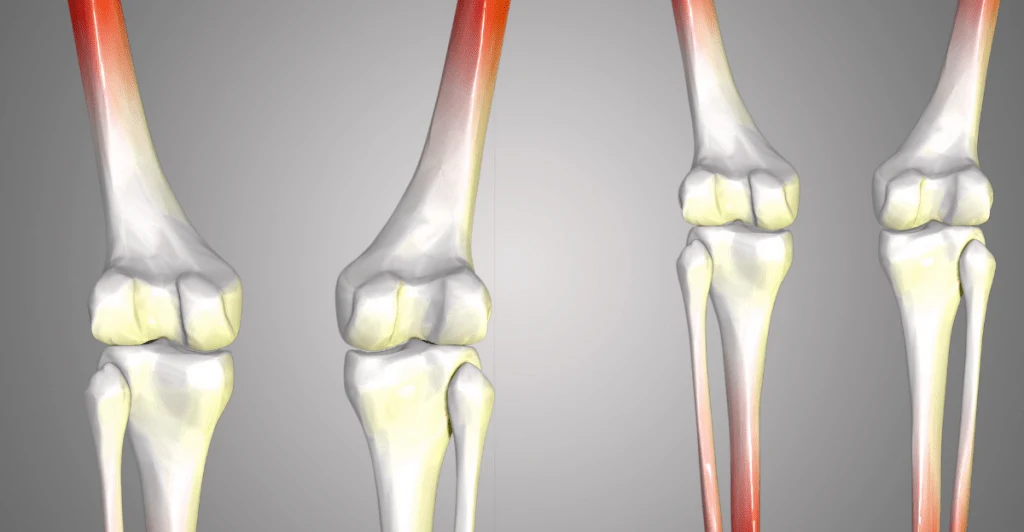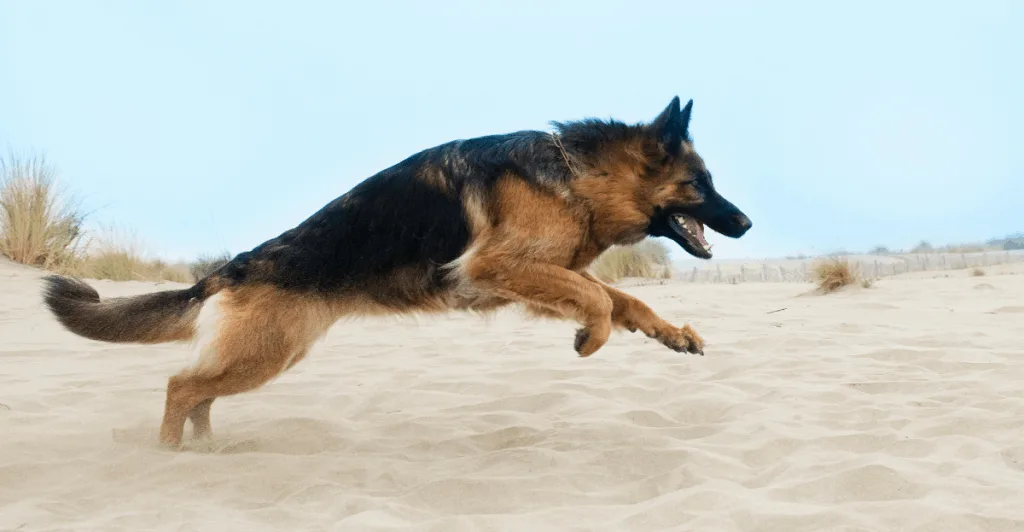
German Shepherds are the second most popular breed of dogs in the United States. These lovable giants can act both as a ferocious guard dog and a cuddly house dog.
But a lot of potential owners may get discouraged when they learn how susceptible this breed is to health and joint problems in their elder years.
German Shepherds are prone to joint problems. The three most common causes of joint problems in German Shepherds are hip and elbow dysplasia, Panosteitis, and Degenerative Myelopathy. The most effective way to prevent and treat GSD joint problems is to encourage healthy weight loss.
In this article, I will discuss joint problems in German Shepherds in detail.
I will start with the symptoms, before moving on to the three most common diseases and then finally end with some useful suggestions.
Click Here to Jump to a Section
How to Tell if Your German Shepherd Is Suffering From Joint Problems
There are some tell-tale signs that owners will start to notice when their German Shepherds succumb to joint problems. These include:
- An overall decrease in energy levels. You may start to notice that a normally energetic and playful dog suddenly stops showing any interest in all physical activities.
- A change in the dog’s mood. The problem in their joints causes pain and can lead to a change in your dog’s overall personality and mood. You may notice your dog becoming more aggressive or lazy.
- Difficulty in movement. This is the clearest sign of an underlying joint problem in a German Shepherd. The dog will show difficulty when rising from a rest position or when sitting down. You may also start to notice a change in the dog’s overall gait, and in some cases, you may notice a limp.
In severe cases, dogs will yelp or whimper when they’re moving due to the unbearable pain.
Why German Shepherds Suffer From Joint Problems
There is no doubt that the root cause behind all the joint problems that German Shepherds suffer from is excessive inbreeding.
German Shepherds are one of the most popular breeds of dogs in the world. In the US, they are the second most commonly bred dogs behind Labrador Retrievers.
This popularity has had some negative effects as breeders often choose to breed certain German Shepherds’ lines too closely.
German Shepherds today have become one of the most inbred breeds in the world.
All potential dog owners are advised to stay clear of all the puppy mills that breed dogs unethically to achieve a certain look, not heeding the problems this can lead to in the future.
Joint problems are not the only effect of inbreeding of the German Shepherd lines.
These dogs are also at a higher risk of suffering from heart-related diseases, epilepsy, bloat, or Von Willebrand’s syndrome.
The Three Most Common German Shepherd Joint Problems

Let us start by looking at the three most common joint-related problems in German Shepherds:
Hip/Elbow Dysplasia
Hip dysplasia and elbow dysplasia are the same problems that occur at different joints. They are by far the most common joint problems in German Shepherds.
Hip dysplasia occurs due to malformation of the hip joint, which can lead to the deterioration of the cartilage.
Bones that would be firmly attached to the sockets under normal circumstances will be loose in a dysplastic hip. This will result in the bones rubbing against each other when in motion.
Over time, this can lead to inflammation and problems, such as arthritis or debilitation.
Elbow dysplasia is pretty much the same thing, occurring at the elbow joint.
There are a few things that owners can do to try to help their German Shepherds cope with the pain of Hip/Elbow dysplasia.
For starters, a good diet is an absolute must. Owners must be mindful of feeding their dogs a diet that can help reduce inflammation.
Some examples of anti-inflammatory food for dogs include Broccoli, ginger, blueberries, Curcumin, non-oxidized Omega 3 fats (meat/fish), etc.
Besides a good diet, owners must make sure their dogs have a dry and warm place to sleep in. This is especially crucial if the dysplasia has already triggered arthritis.
Keeping a warm and dry sleeping area ensures that it is free of possible moisture.
Moist sleeping areas can get slippery, and the last thing that you want is a GSD with dysplasia and/or arthritis slipping, as this can do a lot of irreversible physical as well as emotion damage to your already vulnerable dog.
In extreme cases, when owners can feel their dogs suffering, they may choose to give them some pain related to medicine.
If you feel that this is called for with your GSD, don’t hesitate to make an appointment with your veterinarian sooner than later.
You can learn more about GSD hip dysplasia in this great post I wrote for you about the pros and cons of owning a German Shepherd.
Panosteitis
Panosteitis is another common bone problem that affects German Shepherds.
When a dog gets affected with Panosteitis, owners will start to notice two characteristic changes.
- a change in the dog’s overall gait
- an overall decrease in energy levels
To confirm Panosteitis, owners may try to pinch the middle of the affected limb slightly. If affected, the dog will show clear signs of discomfort.
This disease will typically affect the radius, ulna, and humerus of the tibia’s forelegs and femur of the hind legs.
The pain may render the dog unable to walk, and since it affects multiple bones, owners may notice their dogs become lame on one leg for a couple of weeks, followed right after by another.
Fortunately, Panosteitis isn’t very dangerous, and most dogs will recover without treatment.
Owners can help their German Shepherds by encouraging movement and giving them an anti-inflammatory diet.
Degenerative Myelopathy
Another bone-related problem affecting German Shepherds is Degenerative Myelopathy.
Degenerative Myelopathy affects the dog’s spinal cord, which in turn results in an unsteady gait and overall weakness in the muscles.
Unfortunately, there isn’t much that can be done for dogs suffering with Degenerative Myelopathy.
Unlike the previous two problems, Degenerative Myelopathy does not cause a lot of pain for the dog, although it can affect their life quality.
A good nutritionally rich diet and plenty of exercises are the only two proven remedies for the problem.
A great way to supplement nutrients in your German Shepherd’s diet is with a joint relief supplement. You can shop around for one that you prefer, but I personally use Doggie Dailies Glucosamine for Dogs.
This particular brand is full of ingredients that support joint health, including:
- Glucosamine HCI: rebuilds the “cushion” that surrounds joints
- Chondroitin: prevents breakdown of and repairs cartilage
- MSM: reduces joint pain and inflammation
- Yucca Schidigera: helps prevent onset of arthritis
- CoQ10: good for treating inflammation
- Hyaluronic Acid: an anti-inflammatory agent
- Omega 3: another anti-inflammatory agent
Treatment of Joint Problems in German Shepherds
The first thing I recommend you do when you start noticing symptoms of joint problems in your German Shepherd is to take her to the vet. The vet will access the dog’s case and suggest the best remedies.
A very important step in the treatment of joint problems in any dog is weight loss.
I’ve written a great article for you right here all about how to tell if your German Shepherd is overweight.
Joint problems usually occur in older dogs. But unfortunately, older dogs also tend to be bulkier than younger dogs since they get less exercise.
As an owner, it is your responsibility to help your German Shepherd lose weight using dietary control and exercise.
This can go a long way in relieving your dog’s pain as more weight tends to affect problematic joints. Try getting your dog some exercise everyday even if they seem hesitant.
Also, you might want to decrease the overall amount of food you give to your German Shepherd. Older dogs live a more sedentary lifestyle. So as a result, a lot of the food she consumes gets stored as extra fat.
You can also try adding some anti-inflammatory ingredients such as meat or fish high in Omega 3 fats to help your dog cope.
Anti-inflammatory foods are exactly like they sound: they help reduce the inflammation caused by joint problems.
Besides omega 3 rich meat and fish, other anti-inflammatory foods include vegetables like broccoli, cauliflower, pumpkin, kale, and berries, such as blueberries and cherries.
Final Thoughts
Of all the popular breeds of dogs, German Shepherds stand at a disproportionately high risk of joint problems.
This is mostly the result of unethical breeding practices by breeders over the generations to achieve a certain look for the dog.
The most common joint or hip-related diseases in German Shepherds include Hip/Elbow Dysplasia, Panosteitis, and Degenerative Myelopathy.
Most joint-related diseases make it difficult for the dog to move and may lead to painful arthritis or even debilitation in severe cases.
Remember that, as a German Shepherd owner, it is your responsibility to notice the symptoms and provide your dog with the care she needs.
